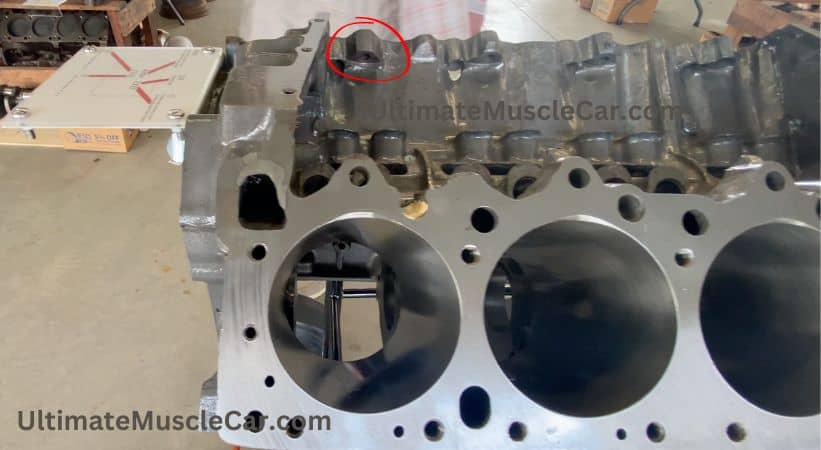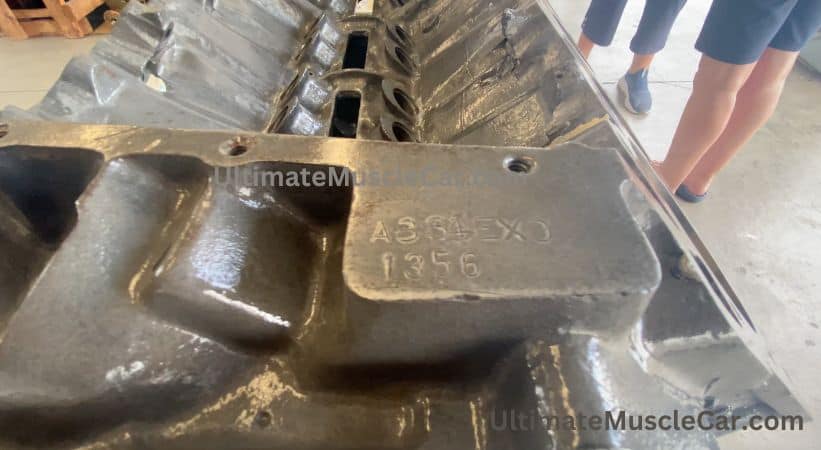Earliest Surviving 426 Hemi Engine Block: The 1st 426 Hemi?
During my last visit to the Chrysler Nationals I visited one of the earliest 426 Hemi engine blocks. Let’s examine why this block is the earliest surviving 426 Hemi engine block.
The 426 Hemi engine block has an early casting date of 10/17/63. The letters, EXO, on the engine pad and poor casting areas throughout indicates the block was used for testing evaluation. The AAQA R stamping on the front of the block was only present on the first 426 Hemi blocks produced.
Let’s take a closer look at the engine block’s characteristics, features and speculation from Chrysler executives about its history.
Earliest Surviving 426 Hemi Engine Block
One of the many reasons I visit the Chrysler Nationals in Carlisle, Pennsylvania every year is the displays like the one found this year.
The outside of a building had a sign stating, “Earliest 426 Hemi Engine.” I rushed in and quickly saw a Hemi engine block bolted onto a stand. I have read stories about it in the past but never saw it in person.

The display sign indicated the first 426 Hemi. The following video of the earliest surviving 426 Hemi engine block was taken be myself.
Let’s take a close look at the Mopar block and its design details which indicate it as an early block.

Casting Date
The casting date on the side of the block reads 10/17/63. This is a very early casting date which indicates it as one of the first 426 Hemi blocks casted.
The book, Chrysler Engines 1992-1998, by Willem L. Weertman, Weertman indicates the first Hemi block placed on a dyno occurred on December 6, 1963.
Weertman also indicates the endurance cracking of the blocks was bought to his attention at the end of January 1964.

This information would indicate the block in this article may not be the very first one produced but it is likely from the first 426 Hemi engine casting molds. The same blocks which had cracking problems before the issues were fixed.
The block in this article has evidence of cracking issues which is discussed down further in this article.
Front of the Engine Block Stamping
Prior to the 1964 Race Hemi, the big dog on the block was the 426 Max Wedge Engine.
The block was used as the base for the new Hemi. It was converted to accept the new Hemi heads.
Those engine blocks had casting marks on the front of the engine to the right of the water pump area.
The letters AAQA, which was common on many blocks during the era, and then a sideways 2R. The letters 2R were common on the Max Wedge blocks.
The 426 Hemi block discussed in this article, had similar lettering cast in the same location with the letter R to the side of the AAQA letters.

Engine Block Casting, Cracking and Repairs

The engine block has many distinct characteristics which indicate it is an early testing block.
- Poor casting in many areas
- Excessive clearance in the pushrod area
- Shorter head stud bosses
- Welded repairs at the water inlets
- Epoxy and bushings placed in pushrod/lifter bores

Engine ID Pad
All the Mopar engine blocks during the era have an ID pad with stampings consisting of numbers, letters and symbols.
The ID stampings on the block weren’t consistent with a production block.
The stampings included the following:
- A864
- EXO
- 1356

A864 was the engineering charge numbers for the NASCAR Hemi project.
EX indicates experimental. O means the engine was probably built to evaluate valve train function, engine clearances, oiling and other functions.
135 is thought to indicate building 135. Building 135 was located at the Highland Park Headquarters and it was where the dynos were located for engine testing.
6 is thought to indicate dyno cell 6, either “a” or “b.”

The Earliest 426 Hemi Block History
After testing was completed, the test Hemi blocks were typically slated to be sent to by-products for sale as scrap. Willem Weertman speculated this block “fell out the back door” and then passed from racer to racer.
Speculation from Chrysler engineers and Mopar enthusiasts think the block may have been shipped to the 1964 Daytona 500 as one of the following:
- A spare block
- Complete short block
- Completed long block
After the race the block may have been stripped of its parts and set aside.
Years later the block was spotted at a local swap meet in Melbourne, Florida. Mopar collector, Jim Ludera, noted the casting date and ID pad stampings.
Jim checked with Chrysler engineers from the Hemi era whom identified the block as one of the early Hemi blocks.

Jim had the block immersed in an alkaline solution and had it stripped down and cleaned up. A local painter preserved the metal to keep it from degrading anymore.
Jim now takes it to Mopar shows and shows it for people like you and me to enjoy.
Just think what may have happened to this piece of Mopar history if Jim never went to that swap meet and found this block.
For the past 40 years, I’ve been traveling to the Chrysler Nationals in Carlisle, Pennsylvania. The event has helped me with studying and researching Mopar engine specs, rods and bearings like the 426 Hemi.
If you have any questions about the 426 Hemi Engine, posts or more information you’d like to contribute, send us an email found specifically on our contact page.
Read More Mopar Engine Articles
Hemi Specifications – Complete Engine Specs
First Nascar 426 Hemi Intake Manifold
Article Resources
- Google Books: Chrysler Engines 1922-1998
